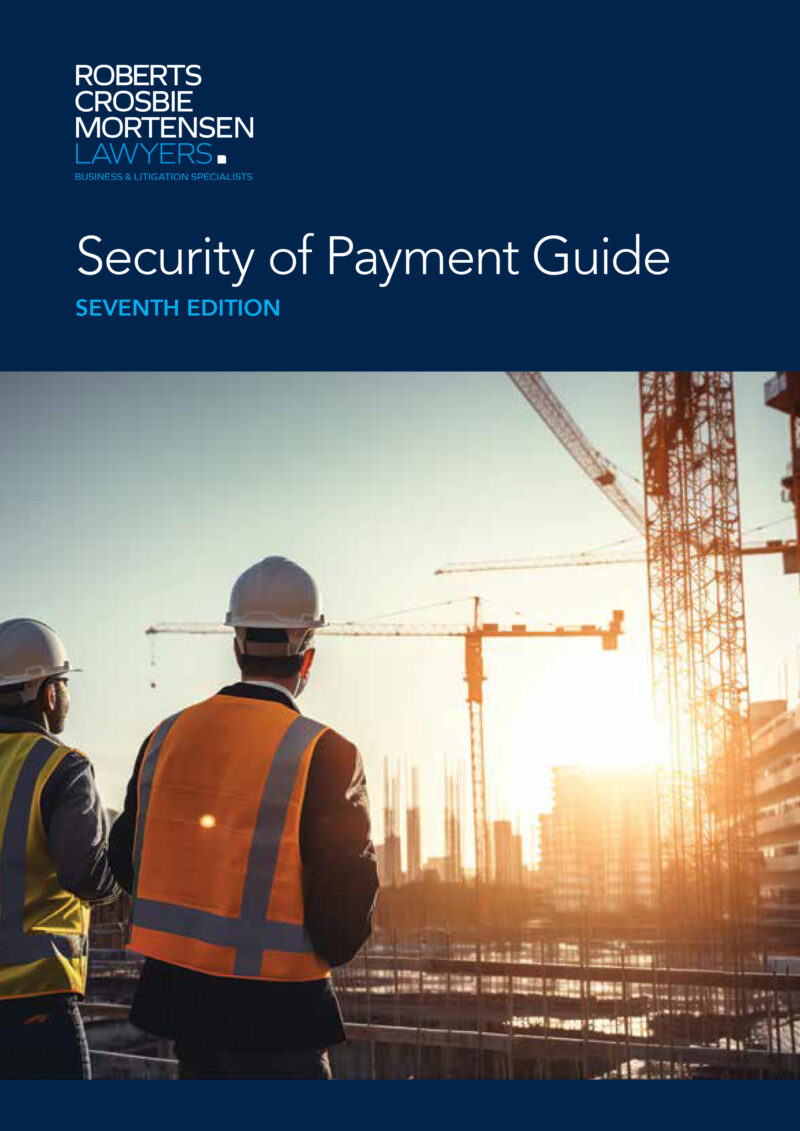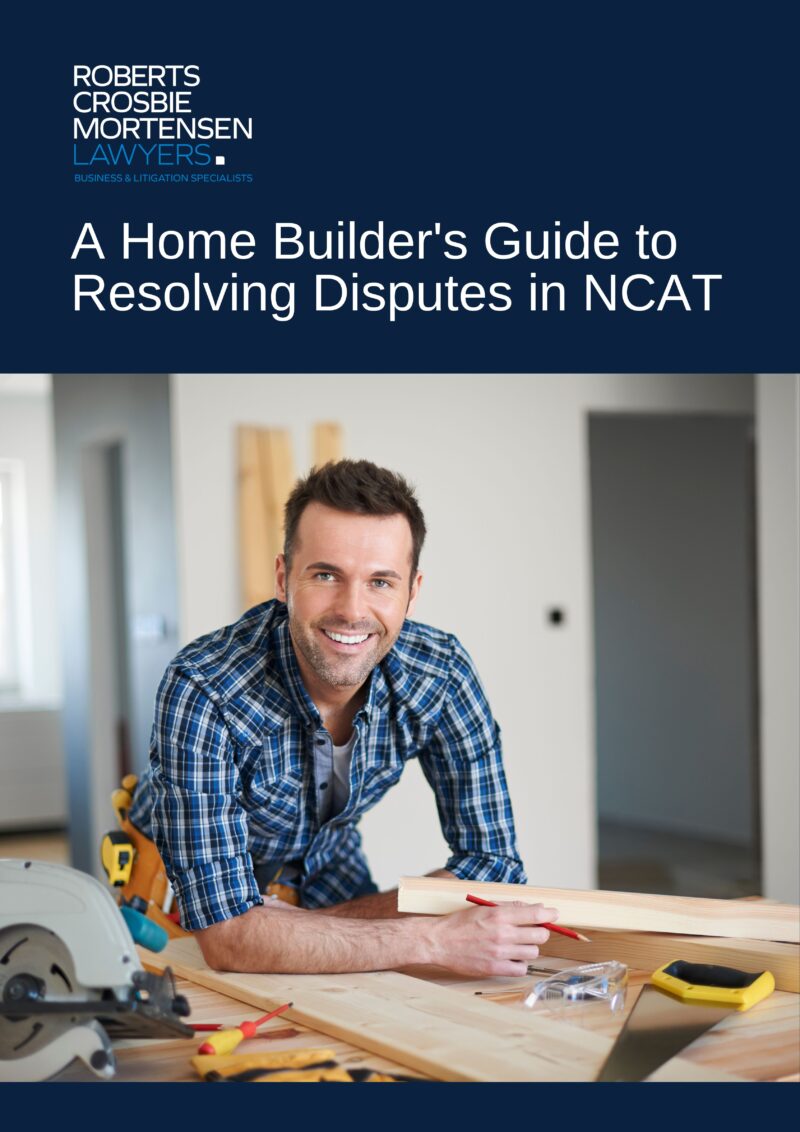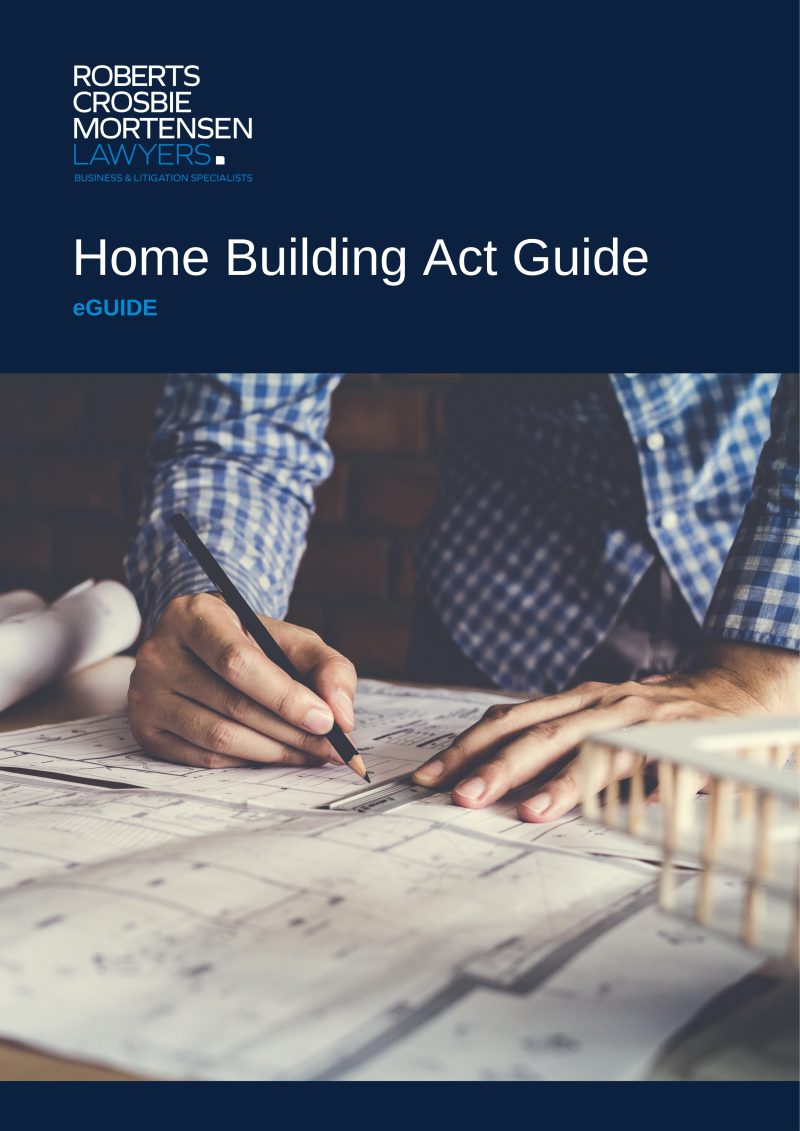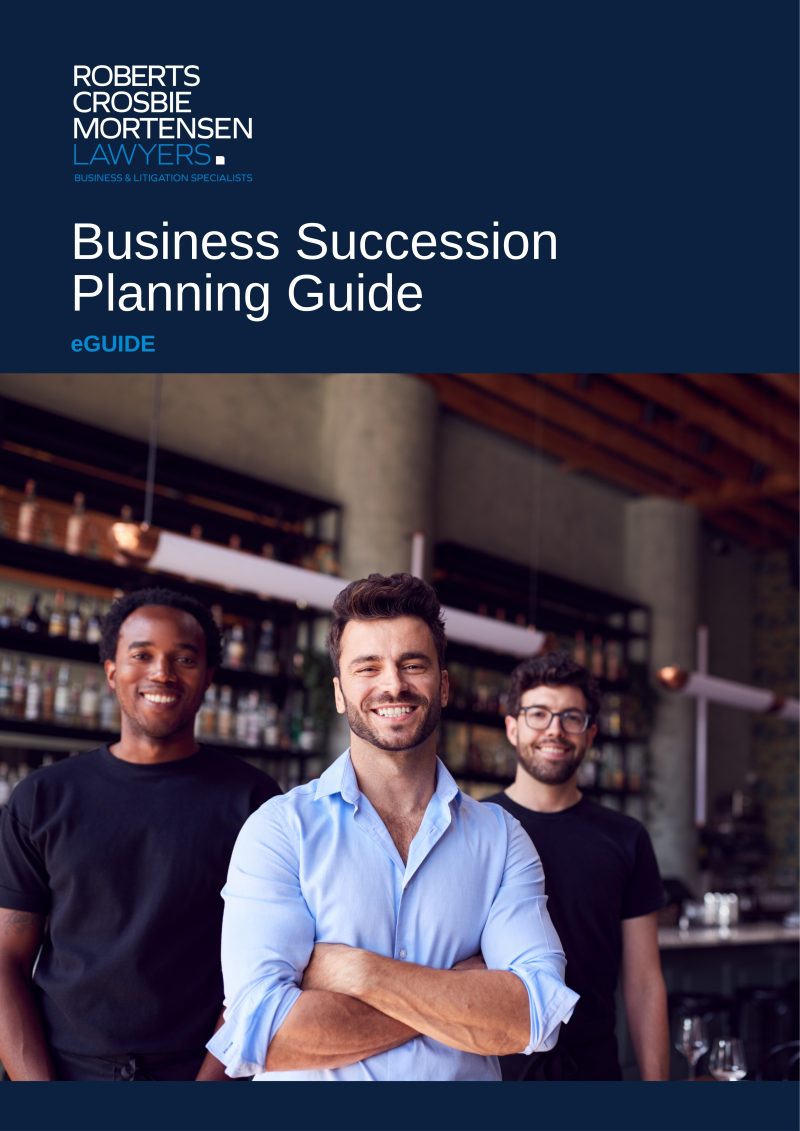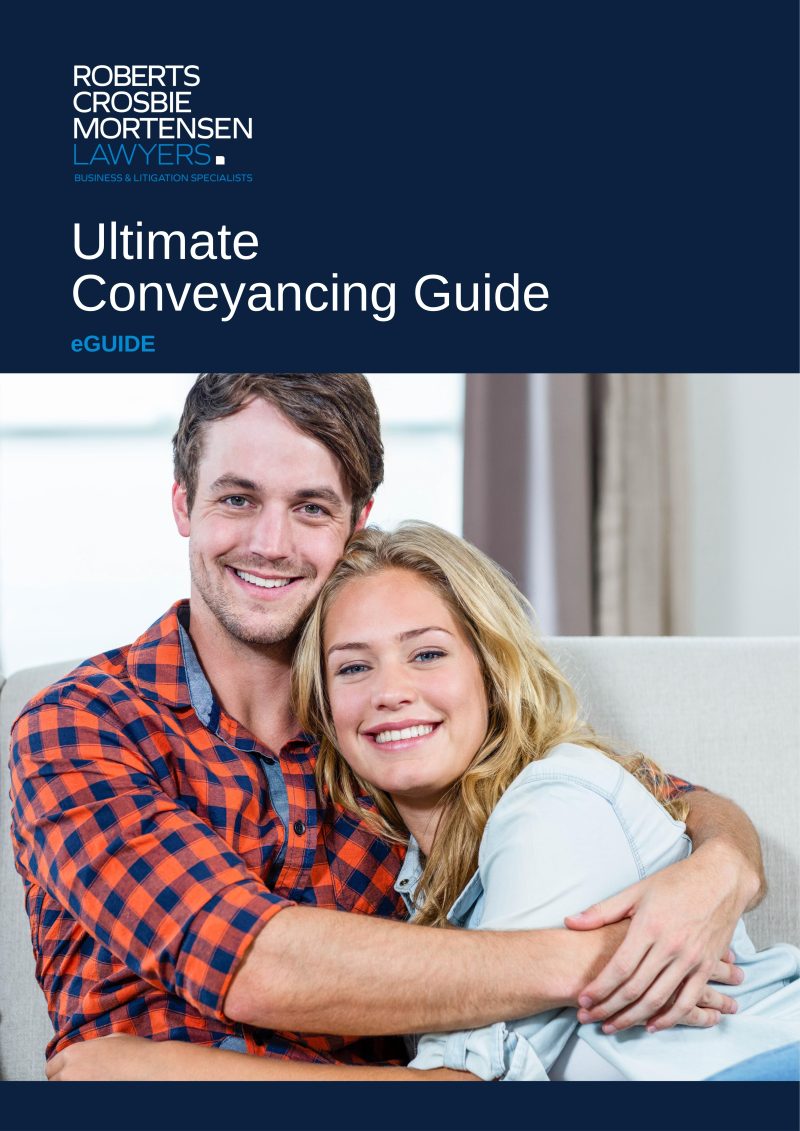A Home Builder’s Guide to Resolving Disputes in NCAT
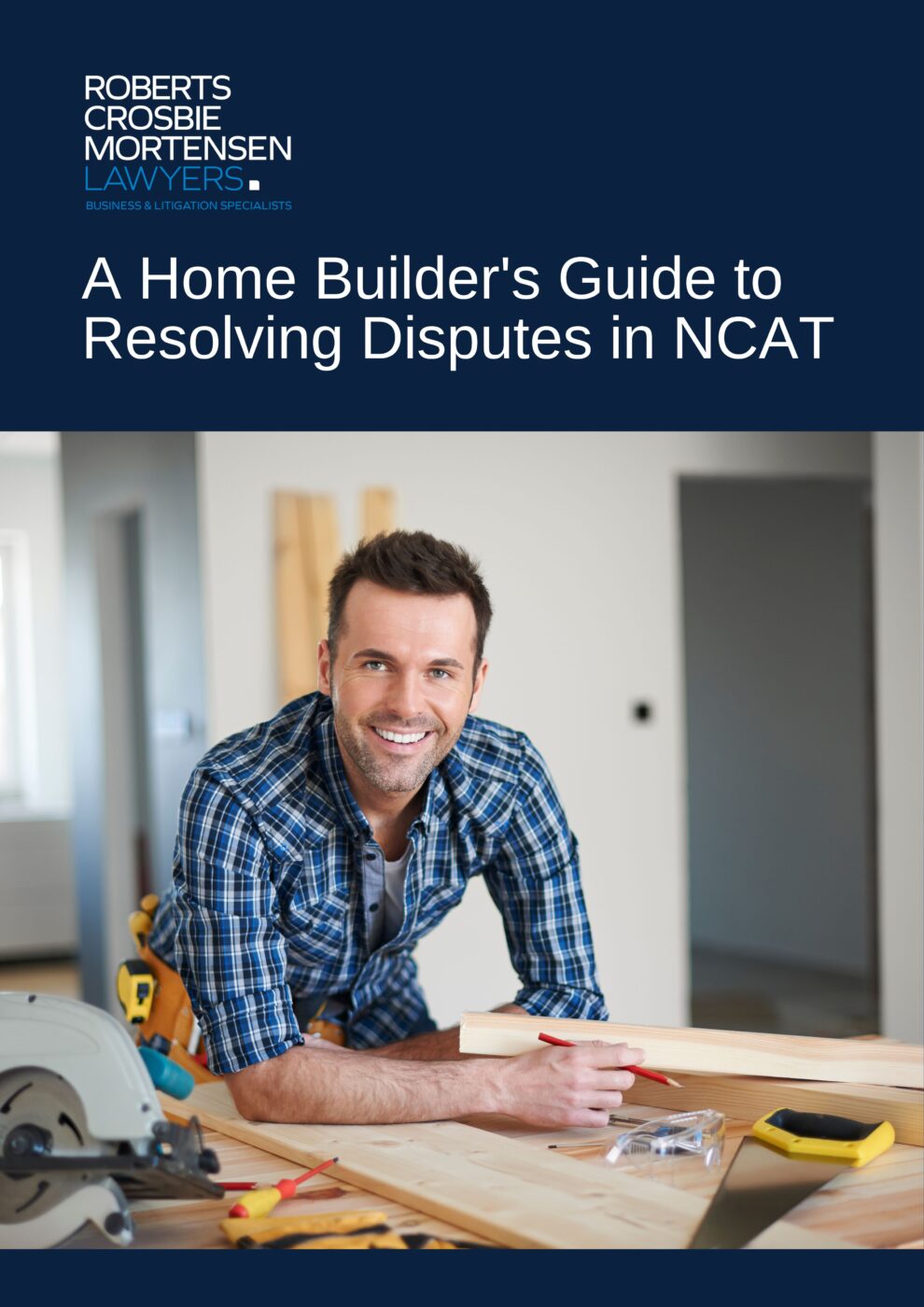
NCAT Proceedings can be stressful, protracted and expensive. Importantly, rights under the Building and Construction Industry Security of Payment Act 1999 (NSW) can be enforced and Adjudication Applications made and determined notwithstanding that NCAT Proceedings are already on foot.
If you are owed money by a Homeowner, in addition to bringing a Claim or Cross Claim in NCAT, you can and SHOULD consider how to use the Security of Payment Laws to obtain an enforceable interim statutory right to payment.
The ability to enforce an interim statutory right to payment can empower a Builder to leverage that right or statutory debt to negotiate an early final settlement of a building dispute or NCAT claim and thereby avoid the stress and costs of protracted NCAT Proceedings altogether. In the event that a settlement cannot be reached, the Builder can recover the amount owing to assist their ongoing cash flow needs and/or to fund legal costs of defending the NCAT Proceedings.
A statutory right to payment can arise if:
- a Homeowner does not respond to a valid Payment Claim with a Payment Schedule within the allowed time,
- a Homeowner provides a Payment Schedule but does not pay the Scheduled Amount by the due date for payment, or
- an Adjudicator makes a Determination in relation to the amount payable in respect of a Payment Claim.
For a Fixed Fee Initial Consultation in relation to enforcing your rights under Security of Payment Laws speak to one of our expert Building and Construction Lawyers today.
A Builder’s Guide to Resolving Disputes in NCAT
This Guide was written for Builders involved in disputes before the New South Wales Civil and Administrative Tribunal (“NCAT”).
This Guide covers all stages of NCAT Proceedings from receipt of the first Notification of Hearing, right through to determination. It will help Builders understand what is required to develop and maintain a robust defence of a dispute in NCAT.
There can be serious consequences for Builders that find themselves before NCAT without the right Legal Representation.
Not only might a Builder lose the case itself and be ordered to pay substantial sums of money to a Homeowner, but they can also face Orders to pay the legal costs of the Homeowner and the suspension or cancellation of their Contractor Licence by Fair Trading.
Don’t get caught out, get the right advice and get it fast.
The Evolution of NCAT
In July of 2001, the NSW Parliament passed into legislation the Home Building Legislation Amendment Bill 2001. One of the objectives of that legislation was to streamline the resolution of residential building disputes by conferring jurisdiction on the then Fair Trading Tribunal to hear and determine ‘building claims’. Building claims were defined to be, disputes relating to residential building work between a consumer and a residential Builder, a residential Builder Contractor and a Subcontractor, or between a claimant and an insurer under the Home Warranty Insurance scheme.
Where a residential building dispute arose, the following process was to be followed:
- The aggrieved party would be able to contact the Fair Trading Tribunal and the relevant building dispute would then be evaluated for the purpose of determining whether the matter was appropriate for assessment by an independent expert.
- If the dispute could not be resolved through informal discussions between the independent expert, the consumer and the Builder or insurer, a building claim could be lodged with the Fair Trading Tribunal.
- Following the Hearing the Tribunal would be able to make Orders binding on all the parties to the proceedings.
Very shortly after that, in the same year, further legislation was passed that established the Consumer, Trader and Tenancy Tribunal (CTTT), a Tribunal that was effectively a merger of the Fair Trading and Residential Tribunals. The CTTT thereafter had jurisdiction to determine residential building claims until it was abolished in early 2014 to make way for a new “super tribunal”, the New South Wales Civil and Administrative Tribunal (NCAT).
NCAT is headed by a Judge of the Supreme Court of NSW and hears a range of administrative and civil matters including residential building disputes.
The NCAT structure also includes Principal Members, Senior Members and General Members. Tribunal Members are the decision makers of NCAT.
In 2001 the Home Building Legislation Amendment Act 2001 amended the Home Building Act 1989 (“HBA”) to ensure easy access to legal resolution for residential building industry participants. After more than 20 years the dispute resolution process remains much the same, save for the appointment by NCAT of experts.
An aggrieved party who wishes to bring a residential building dispute before NCAT will almost always be required to first refer the dispute to Fair Trading. If a resolution cannot be reached, Fair Trading will then refer the matter to NCAT.
NCAT is designed to be less formal, cheaper, and faster than Court proceedings. NCAT operates in a way that accommodates and facilitates access to the justice system by self represented parties. However, in residential building disputes where the value of the dispute exceeds $30,000, NCAT will generally allow legal representation upon application by the parties. That application for representation will usually be made by your Lawyer on the first occasion that they are before NCAT on your behalf.
In the year ending 30 June 2022, NCAT finalised more than 3,000 applications made in relation to residential building disputes.
BUILDERS TIPS
- Refer to the Member as ‘Member’ or ‘Senior Member’. If you are unsure of the term, the safest bet is simply to call them ‘Member’ – but they will introduce themselves at the beginning of the Hearing, and they will generally have a small nameplate on their bench indicating their correct title and name.
- Treat the Member as if they are a Judge in Court – you should be respectful, courteous and patient.
- Ask questions if you are not sure about something. The Member is there to help.
- Do not interrupt the Member, or the other side.
Home Building Applications
The legal right of a Homeowner to apply to NCAT for determination of a building claim arises from Part 3A of the Home Building Act 1989 (HBA).
A “building claim” is a claim that arises from a supply of building goods or services whether under a contract or not, for:
- The payment of a specified sum of money,
- The supply of specified services,
- Relief from payment of a specified sum of money,
- The delivery, return or replacement of specified goods or goods of a specified description, or
- A combination of two (2) or more of the remedies referred to in paragraphs (1)-(4).
“Building goods or services” means goods or services supplied for or in connection with the carrying out of residential building work or specialist work (including plumbing and drainage work, other than roof plumbing work, gas fitting work and electrical wiring work).
The claim commences when NCAT accepts lodgement of a Home Building Application form from the Homeowner, which will indicate the Orders they are seeking and reasons why the Orders are necessary, along with any supporting documents. It may also include Expert Reports detailing defective or incomplete work if the Homeowner has obtained these.
In determining a building claim, the Tribunal is empowered to make one (1) or more of the following Orders as it considers appropriate:
- An Order that a party to the proceedings pay money to another party or to a person specified in the Order, whether by way of debt, damages or restitution, or refund any money paid by a specified person.
- An Order that a specified amount of money is not due or owing by a party to the proceedings to a specified person, or that a party to the proceedings is not entitled to a refund of any money paid to another party to the proceedings.
- An Order that a party to the proceedings:
- do any specified work or perform any specified service or obligation arising under the HBA or the terms of any agreement, or
- do or perform, or refrain from doing or performing, any specified act, matter or thing.
The Tribunal can make an Order even if it is not the Order that the Applicant asked for.
The purpose of Orders made by the Tribunal is to put the Homeowner (Applicant), as far as is possible, in the position that they would have been in had the Builder correctly performed all of their contractual obligations in a good, timely and workmanlike manner.
A Homeowner cannot claim an extravagant sum without cause, and they must be able to prove any defects or damage that the Orders sought will rectify.
The jurisdiction of NCAT to hear and determine any building claim is limited to claims that do not exceed $500,000.
It is important to remember that NCAT will accept almost all Applications made, even if the claim does not have merit or prospect of success.
The first time that the Application will be reviewed and assessed by the Tribunal is at the First Directions Hearing.
BUILDERS TIP
- If it is your view that the Homeowner’s Application is completely without merit, then it is best that you talk to a specialist Building and Construction Lawyer about making an application to have the matter discontinued at the First Directions Hearing.
The three (3) most common building claims made by Homeowners are for financial compensation for defects, incomplete work or delays. These claims are founded upon breaches of contract and can be bought by the Homeowner either individually or in combination.
It is useful at this point to briefly discuss the Statutory Warranties of the HBA (reproduced below).
The effect of the inclusion of the Statutory Warranties in the HBA is that all contracts for residential building work are to be read to include those terms (warranties), even if those terms are not included in the written contract. Having said that, the three (3) most common standard forms of contract used in New South Wales, namely, those of the Housing Industry Association, the Master Builders Association, and the Department of Fair Trading, all contain terms that mirror the Statutory Warranties.
The Statutory Warranties are as follows:
- A warranty that the work will be done with due care and skill and in accordance with the plans and specifications set out in the contract,
- A warranty that all materials supplied by the Builder will be good and suitable for the purpose for which they are used and that, unless otherwise stated in the contract, those materials will be new,
- A warranty that the work will be done in accordance with, and will comply with the HBA or any other law,
- A warranty that the work will be done with due diligence and within the time stipulated in the contract, or if no time is stipulated, within a reasonable time,
- A warranty that if the work consists of the construction of a dwelling, the making of alterations or additions to a dwelling or the repair, renovation, decoration or protective treatment of a dwelling, the work will result, to the extent of the work conducted, in a dwelling that is reasonably fit for occupation as a dwelling, and
- A warranty that the work and any materials used in doing the work will be reasonably fit for the specified purpose or result.
Let’s now consider each of the three (3) most common claims.
(1) Defects and (2) Incomplete Work
These two (2) claims combined are by far the most common claim made by Homeowners and in a nutshell, arise from a Homeowner’s claim that the work breached the statutory warranties by not complying with the plans and specifications, and not complying with the National Construction Code.
Claims made by Homeowners for defects and incomplete work will require evidence be put to the Tribunal, normally in the form of an Expert Report, of the defects said to be within the works. The Builder will then usually be given the opportunity to provide an Expert Report in reply. See Part 3 – Documents and Evidence for more about Expert Reports.
The remedies sought by Homeowners in claims for defective and incomplete work can be either Orders for financial compensation for the cost of repairs and completion or Orders compelling the Builder to rectify and complete the work.
(3) Delays
Another common claim bought by Homeowners are claims for damages for delay. These claims can be bought either as claims for liquidated damages or claims for damages at large.
Liquidated Damages
Liquidated damages are a sum of money agreed upon by the parties in a contract that the party in breach must pay to the nonbreaching party in the event of a breach. They are essentially preagreed compensation for the harm that is anticipated to result from a delay in project completion.
For example, if a Builder fails to complete a construction project on time, the contract may provide for liquidated damages in the amount of $X for each day that the project is delayed. That amount is intended to compensate the Homeowner for the additional costs and inconvenience caused by the delay, without requiring them to prove the exact extent of their damages.
It is important to note that liquidated damages are only enforceable if they are reasonable and not deemed to be a penalty. NCAT will usually only award liquidated damages where the agreed amount is a reasonable estimate of the likely damages.
It is equally important to note, if the contract has only allowed a nominal amount for liquidated damages (for example $1.00 per day which is included by default in many standard contracts), that figure will not be recognised as a limit to damages claimable by the Homeowner. The NSW Supreme Court has recently ruled that the effect of such provisions would be to allow the Builder to “contract out” of their statutory warranty obligations, and this cannot be allowed as contracting out the statutory warranty provisions is prohibited by the HBA.
Claims for liquidated damages are usually far easier to prove than claims for damages at large.
Damages at Large
Damages “at large” or common law damages, will usually be claimed by Homeowners in cases where:
- There is no provision for liquidated damages in the contract,
- The Builder has scheduled an amount of liquidated damages which is nominal, or
- The contract has been terminated.
The purpose of such claims is to recover the loss or damage to the Homeowner of the Builder’s late delivery of the project, and often include claims for interest on loans, rent lost or paid, and other expenses said to be incurred.
Generally speaking, claims for damages at large are usually more difficult to prove and will be subject to higher scrutiny from NCAT both in relation to the cause of the delay and the amount of compensation being sought.
Many Homeowners grossly overestimate the Builder’s liability for delay claims, and in recent years an increasing number of decisions made by NCAT have set a progressively difficult standard of proof for Homeowners who claim that a Builder’s delay is unreasonable. See our article below covering what Builders should be when faced with a dispute with a difficult Homeowner.
In some building disputes, Builders may have valid grounds to make a cross claim against the Homeowner.
The most common building dispute where Cross Claims are filed are those where the Homeowner has not paid the Builder on the basis that they have an offsetting claim of defects or incomplete work.
By a Cross Claim a Builder can seek work Orders, money Orders or other Orders.
A Cross Claim is a separate Application for Orders against the Applicant Homeowner relating to the same dispute. Generally, cross claims will be heard together with the initial application.
BUILDERS TIPS
- Cross claims should be lodged before the date of the First Directions Hearing (which will be noted on the Notice of Hearing you receive from NCAT). This means that, as soon as you receive the Notice of Hearing, you should seek legal advice to determine whether you are able to lodge a Cross Claim against the Homeowner.
- Where a Builder believes they have a cross claim, they may also have a claim against the Homeowner under the Building and Construction Industry Security of Payment Act 1999 (NSW) which can result in faster resolution of a Builder’s claim for a progress payment and an enforceable interim statutory right to payment. Importantly, claims under Security of Payment Laws can be made notwithstanding that NCAT Proceedings are already on foot.
- It is important to obtain legal advice in relation to any claims under Security of Payment Laws quickly as strict time limits apply. You should, therefore, seek legal advice immediately if you suspect you may be able to make or enforce a Payment Claim.
- NCAT does not have jurisdiction to determine an application arising under the Building and Construction Industry Security of Payment Act 1999, so subject to legal advice, it is likely your claim will be bought concurrently by either Adjudication or as a claim for statutory debt, usually in either the Local or District Courts.
Download our Security of Payment Guide for more information.
Award of Costs in NCAT
In residential building disputes where the amount claimed exceeds $30,000, the unsuccessful party will generally be ordered to pay the successful party’s legal costs, or at least a substantial part of them. There are sometimes exceptions to this rule that can arise in certain circumstances, and a good Building and Construction Lawyer will seize on any opportunity to use such circumstances to your advantage.
If you as the Builder are not represented in an NCAT Hearing, you are not eligible to recover the costs of your defence. However, if the Homeowner is represented you may still have to pay theirs.
Legal costs are awarded on either a party party basis or an indemnity basis. As a rule of thumb, a party party basis will usually equate to 65%-70% of the legal costs, whist indemnity costs will usually be in the range of 90%-100% of the legal costs.
The legal costs of bringing a claim in NCAT when a Homeowner has engaged a Solicitor can often run anywhere from tens of thousands of dollars into hundreds of thousands of dollars. Liability for legal costs and the difference between party party costs and indemnity costs can be considerable. It is essential, therefore, that Builders are aware of the real risk they face when involved in NCAT Proceedings, namely, potential liability for the damages claimed plus the Homeowners’ legal costs.
There are three (3) practical ways of avoiding or minimising liability for a Homeowners’ legal costs. These are:
- Defeating the claim at a Final Hearing (unless the outcome was still less favourable for the Homeowner than an offer of settlement previously made by the Homeowner),
- Negotiating a settlement of the claim, and
- Relying on an offer of settlement that was not accepted, and which would have resulted in a more favourable outcome for the Homeowner than that which the Homeowner achieved at a Final Hearing.
The Tribunal has a discretion when awarding legal costs, and in situations where a Homeowner would have obtained a better outcome had they accepted a Builder’s earlier offer of settlement, the Builder will be a prime position to not only argue that the they should not have to pay the Homeowners’ legal costs from the date the offer was made, but that the Homeowner should have to pay the Builder’s legal costs from that date assessed on an indemnity basis.
The potential liability for another party’s legal costs, particularly costs assessed on an indemnity basis, therefore encourages both Builders and Homeowners to make commercial offers of settlement and requires that offers are considered carefully when received.
Rules around legal costs can be tricky, and the form of an offer is important for ensuring that an argument in relation to costs can be effectively made if the offer is not accepted. Offers of settlement should also be clearly stated to be made on a without prejudice basis to avoid the risk that a Homeowner will try to introduce the offer into evidence as an admission of some fault or liability.
The take away here is simple, if you are involved in NCAT Proceedings and want to not only avoid liability for legal costs but position yourself to be able to recover costs against the Homeowner, speak to a specialist Building and Construction Lawyer without delay.
If you as the Builder are not represented in an NCAT Hearing, you are not eligible to recover the costs of your defence. However, if the Homeowner is represented you may still have to pay theirs.
BUILDERS TIP
- Given that an unsuccessful Builder can be ordered to pay the legal costs of the Homeowner in addition to the claim for damages and their own legal costs, it is essential to seek the help of a specialist Building and Construction Lawyer at an early stage to minimise the potential risks of adverse Cost Orders and/or to set up the Homeowner for Costs Orders in favour of the Builder in the event that a reasonable commercial offer is made and not accepted.
NCAT Procedure Generally
Part 1 – The Dreaded Letter From NCAT

It is unusual for Builders to be surprised by a Notice of Directions Hearing notifying that a Homeowner has commenced proceedings in NCAT. This is because in most cases Builders will have already been contacted by the Department of Fair Trading in an attempt to resolve the complaint which has ultimately led to litigation. Nevertheless, getting the dreaded Notice of Directions Hearing will still bring a terrible, sickly feeling to most Builders.
BUILDERS TIPS
- There is a lot of useful information in the Notice.
- Firstly, check the parties’ names. Does the Applicant Homeowner’s name match that of the person with whom you contracted to complete the work? Is the Applicant suing you in person or are they suing your company? What is the date and time you are required to attend? All of this is important information that will assist your Solicitor and is readily available on the Notice.
- Next, the first Notice of Hearing will ordinarily enclose a copy of the Homeowner’s Home Building Application. This too is a trove of useful information, including:
- What Orders the Homeowner wants NCAT to make;
- If it is a monetary claim for damages, the amount the Homeowner claims; and
- The reasons for the Homeowner making the Application.
A Notice of Hearing will list the Hearing type, date, time and location. If you are unavailable to attend the Hearing at the appointed time, you must let NCAT know with as much notice as possible. If you do not attend a Hearing, the matter may be decided in your absence, and worse, there is every chance that the decision will not be in your favour.
Remember, NCAT accepts all Applications made whether or not they have any merit. The first time that the matter is reviewed and assessed before NCAT is at the First Directions Hearing. Therefore, the first thing you should do upon receiving a Notice of Hearing is to seek legal advice.
Part 2 - The First Directions Hearing
The first listing date will be noted on the Notice of Hearing and is the first time the matter will come before the Tribunal. In most cases it is about six (6) to eight (8) weeks after the Application is received and processed by NCAT.
If the amount of the claim is less than $30,000, the first listing will usually be a Conciliation Hearing. If the claim is for more than $30,000, it will usually be a Directions Hearing.
Generally speaking, a party cannot be legally represented in the NCAT Home Building List unless the Tribunal gives express permission for representation. However, this will normally be given as a matter of course in cases where the amount claimed exceeds $30,000, or if there are complex legal issues involved.
BUILDERS TIP
- Whilst it is best practice for your Lawyer to write to NCAT prior to the first Hearing requesting permission to represent you, it is quite common for Lawyers experienced with NCAT procedures to make an oral application to represent you at the time of the first Hearing.
If the claim is for less than $30,000, the first Hearing will usually be a Conciliation Hearing.
NCAT encourages parties to attempt to settle the issues between the parties prior to the substantive Hearing of the matter. As such, the first Hearing may start with a Conciliation. The parties will be asked to leave to discuss the dispute and attempt to resolve it themselves, or with the assistance of their Solicitors. A Conciliator may be available to assist, if required.
Most parties will be happier with a settlement that comes from a Conciliation, if one can be reached. This is because they will have had the opportunity to state their grievances and negotiate a resolution, and the agreement will usually “meet in the middle” with both parties conceding and/or succeeding on different points.
If an agreement is reached at Conciliation, everyone will return to the Hearing and inform the Tribunal, and the Member will then proceed based on your agreed resolution (which may include preparing Orders).
If an agreement is not reached, the Member will either proceed with the Hearing (if this is a matter which could be resolved in a short period of time) or make Directions to set a later date for the full Hearing, including making timetable Orders with due dates for filing and service of documentation.
All parties will be given the opportunity to make statements to support their side of the dispute.
BUILDERS TIPS
- Get legal advice from a Building and Construction Lawyer experienced in NCAT Proceedings promptly upon receipt of a Notice of Directions Hearing.
- Make a proper effort to settle the dispute at Conciliation. Chances are that an agreement made at Conciliation may be better for all parties than proceeding to a decision of the Member.
- You are more likely to reach an agreement at Conciliation if you have already obtained legal advice and properly understand the strengths and weaknesses of the Homeowners’ claim, the strength and weaknesses of any cross claim you have, the amount of legal costs involved in defending the claim and the potential liability for adverse Costs Orders.
If the claim is for more than $30,000, the first Hearing will usually be a Directions Hearing.
The Directions Hearing will determine a timetable for the conduct of the matter. This may include:
- Due dates for documents to be sent both to the other side and to NCAT, which can include:
- Points of Claim,
- Points of Defence,
- Points of Cross Claim (if a cross claim is made),
- Expert Reports,
- Scott Schedules, and
- Bundles of relevant documents.
- If there is more than one (1) expert witness, the Member may direct the holding of a conclave. This is an onsite meeting of all of the experts to discuss the issues covered in their reports, in order to narrow and identify those issues that are agreed upon and those that remain in dispute between them. More commonly these days, Orders will be made to produce a Joint Expert Report for the same purpose.
- Alternative dispute resolution, such as Conciliation or Mediation.
- Hearing Dates.
These Directions must be complied with. If you do not file and serve evidence or documents by the dates as ordered, you may not be able to rely on them at the Hearing. If you are unable to comply with the dates as ordered, you will need to seek extensions of time from NCAT. Any request for an extension of time should first be agreed by the other party before the request is submitted to NCAT. However, consent of the other party is not a guarantee that the Member will grant the extension sought.
Persistent failure to comply with the directions may result in the case being dismissed (if the Applicant is not compliant) or the case being decided in the Applicant’s favour (if the Respondent is not compliant).
Either party can ask NCAT to set a second listing date if there is a reason why they are unable to comply with the timetable directions ordered. In this situation, the Member would set a date for a new Directions Hearing, if the request is deemed reasonable.
BUILDERS TIP
- Be mindful of all Directions dates.
Part 3 - Documents and Evidence
The rules of evidence in NCAT are not like the rules of evidence in a Court and almost anything which is relevant to the claim may be submitted as evidence. This can include but is not necessarily limited to; written statements from yourself or witnesses, any documents relating to the building work, the contract and photographs of the work.
If the matter proceeds to a formal Hearing, the Applicant will be required to provide a Points of Claim document. This document sets out and particularises all of the claims they make in the application, and the basis for them.
The Points of Claim may be served together with copies of Expert Reports, invoices, photographs or other documents supporting the Applicant’s claim.
Once the Points of Claim are filed by the Applicant, you may be required to prepare Points of Defence.
Points of Defence are essentially a response to the Applicant’s Points of Claim. They should outline your response to the claim, including any defences, explanations or denials.
Points of Defence must be in point form. They should be brief and succinct, but thorough enough to cover the entire claim. They are what you will be relying on at the Hearing – you cannot make claims during the Hearing about things that are not included in the Points of Defence. They should include by reference any evidence you intend to rely upon, such as an Expert Report.
BUILDERS TIPS
- It is vital for Builders to submit thorough Points of Defence in order to defend a claim. It is best to have an experienced Building and Construction Lawyer draft the Points of Defence and any Points of Cross Claim on your behalf to ensure that a defence to each part of the claim is provided and the legal basis for any cross claim is properly presented. If this is not done properly, you risk not being allowed to defend some parts of the claim, which could be the difference between winning or losing the case.
- Be concise and only talk about things relevant to the Hearing and supported by the evidence.
- Tell the truth. You may be required to take an oath or affirmation that you will tell the truth. It is a crime to break this oath. Decide before the date whether you will take an oath (religious) or affirmation (nonreligious) when giving evidence.
In most building matters, each party will likely need to engage an expert witness to prepare an Expert Report. Although Expert Reports are not cheap, they provide invaluable evidence and can often be the reason a claim is won or lost.
It is important to check the qualifications of the expert you wish to engage to verify their status as an expert. This can be done by reviewing their CV (which they have to provide with any Expert Report), conducting generic research into their background and/or questioning the expert in relation to their experience and the matters they may be asked to address in their Expert Report.
When there is more than one (1) expert witness, the Member may direct the holding of a conclave. This is an onsite meeting of all of the experts to discuss the issues covered in their reports, in order to narrow and identify those issues that are agreed upon and those that remain in dispute between them. More commonly these days, Orders will be made to produce a Joint Expert Report for the same purpose.
Lastly, it is essential to realise that not all experts are created equal. Not only does there often tend to be preexisting bias, the quality of many Expert Reports and the way in which opinions are expressed can frequently leave an expert wide open to effective attack in cross examination at Final Hearing. Some experts will even entirely miss the mark and omit the inclusion of opinion about critical issues that would be of great assistance to their clients.
It is for these reasons that it is essential for Builders to retain an experienced Building and Construction Lawyer to assist with the selection and briefing of expert witnesses at an early stage.
BUILDERS TIP
- It is essential for Builders to engage an experienced Building and Construction Lawyer to select and brief expert witnesses and to review their Expert Report before it is finalised.
One of the most important types of evidence, especially in building defect matters, is the Scott Schedule. A Scott Schedule is a document which outlines:
- What the contract stipulated the building work should include,
- Comments from the Homeowner setting out the alleged defect and an estimate of loss suffered because of it,
- Comments from the Builder either admitting, denying or not admitting the defective work and/or raising a defence, and an estimate of any loss suffered due to it, and
- Comments by the Tribunal Member.
Scott Schedules assist the Tribunal Member to narrow the issues in dispute. If some issues are agreed, they can be put aside. It is an easy way of determining exactly what are the disputed issues and what potential Orders might include, especially money Orders since the Scott Schedule outlines the estimate of loss.
Lay evidence is given by people who are not experts.
Lay evidence is normally given in affidavit form, which is a sworn statement given well in advance of the Hearing.
Generally, lay evidence can only be included if the witness has actually seen or heard the action they are testifying about – it cannot be an opinion, something that another person told them, or be irrelevant material. This means that you cannot give your opinion on the building work; only experts can provide such an opinion.
Lay evidence will generally include the following:
- The Contract itself and any related plans or contract documents,
- Details of any relevant correspondence between the Builder and the Homeowner including emails and text messages, and
- Contextual information surrounding relevant events, including payments, delays and any contract termination.
Part 4 – Settling the Matter before Hearing
All Tribunals and Courts encourage parties to settle disputes prior to Hearing in order to save time and costs for all involved. If the matter settles, the Applicant can withdraw their Application before the Hearing or the parties can agree to final Orders being made by consent. It is strongly recommended that in such circumstances, a Solicitor be retained to provide a Deed of Settlement or form of Consent Orders for the parties to sign.
A Deed of Settlement, Settlement Deed or Deed of Release is a legal agreement that is used to resolve a dispute or settle a claim between parties. It is a formal document that sets out the terms and conditions of the settlement, including the obligations and responsibilities of each party and the terms of payment, if any.
Once a Deed of Settlement is executed it is binding on the parties, and they are required to carry out the obligations outlined in the Deed. The Deed of Settlement may also include provisions for the resolution of any future disputes, such as by Mediation.
BUILDERS TIPS
- It is important to note that a Deed of Settlement in construction disputes should be carefully drafted and reviewed by an experienced Building and Construction Lawyer. This is because properly drafted Deeds will have a binding effect similar to Orders of the Tribunal. The terms of the Deed must be clear and enforceable, and the parties must fully understand their rights and obligations before signing it. The Deed may also be the source of new rights and obligations which, if not clearly stated, may lead to a fresh dispute arising between the parties.
- As a Respondent, if you have incurred costs in defending a Homeowner’s claim, which is ultimately withdrawn, and the issue of those costs is not dealt with by agreement, it may be open for you to make an Application to the Tribunal for Orders that the Homeowner pay your costs.
Part 5 – Hearing
A formal Hearing can take anywhere from less than an hour to several days depending on the number of witnesses and the number and nature of issues in dispute.
The formal Hearing will usually commence with the Tribunal Member encouraging the parties to have a “last ditch” effort at Conciliation, even if Conciliation has already been attempted.
If a Conciliation is then attempted and a resolution is reached you will all return to the Hearing and inform the Member, who will then proceed based on your agreed resolution (which may include preparing and entering Orders).
If a settlement agreement is not reached by any such Conciliation the Tribunal will proceed with the Hearing.
Both parties will be given the opportunity to present their case – starting with the Applicant. Many Tribunal Members will take a collaborative approach, with the Member asking questions or explaining things along the way. It is important to remain concise and only discuss things that are relevant to the Hearing, and not to waffle on about irrelevant facts.
All witnesses relied upon by the parties will be required to attend.
You (or your Solicitor or Barrister, if you are legally represented) will also be given the opportunity to ask the other party questions in cross examination. It is best to write down your questions and wait until the Member gives you this opportunity, rather than jumping in and asking during the other side’s evidence. Do not interrupt the other side or the Member.
The advantages of being represented by a Solicitor or Barrister at a Final Hearing is that you benefit from their knowledge and experience of NCAT Proceedings as well as their ability to skilfully cross examine witnesses (including experts), put your best case forward, highlight the problems with the Homeowner’s case and use the witnesses of both sides to your advantage, where possible.
If you are to give evidence or respond to cross examination, you will be required to take an oath (religious) or affirmation (nonreligious), as a solemn and formal declaration that you will tell the truth.
The Member will direct the course of the Hearing and keep everyone informed of the process. As mentioned earlier, NCAT is designed to facilitate self represented parties, so if you are unrepresented the Member will let you know what will happen next and explain the meaning of this to you.
The Member’s decision may be made at the Hearing or “Reserved”, which means the Member requires time to review and consider their decision.
If the claim is for less than $30,000, a reserved decision is generally given within six (6) weeks. If more than $30,000, a reserved decision is generally given within three (3) months.
Orders made by a Member must be complied with. Noncompliance may result in serious penalties; for Contracting Licence holders, this could include suspension of your Licence.
NCAT will also provide NSW Fair Trading a copy of the Orders against a Builder or tradesperson. If you are the Licence holder, you will be required to notify Fair Trading once you have complied with the Orders (such as completing the work or paying money).
BUILDERS TIPS
- Be prepared to accept the decision the Member makes. However, there is the opportunity to Appeal your case if it meets the appeal requirements.
- Do not dispute the decision unless you have a proper reason to, based on NCAT’s appeal requirements. Unfortunately, there is often one party who comes out of a dispute unhappy with the result.
- If the Homeowner is legally represented, you probably should be too. In fact, unless the amount in dispute is an amount you can comfortably afford to lose, you should engage an experienced Building and Construction Lawyer to represent you in relation to the claim at any early stage to maximise your chance of negotiating an early settlement and ensure that your case is otherwise best prepared and presented at the Final Hearing.
Part 6 – Right of Appeal, Time to Appeal and Practical Issues
There are only very narrow permissible grounds to appeal a decision of NCAT and if you wish to appeal, it is essential that you seek legal advice on the risks, costs, and prospects of success of any appeal contemplated.
You cannot appeal just because you are not happy with the decision or because the decision was not in your favour; an appeal is not a second chance at a Hearing.
Generally, appeals will only be successful if the original Member made an error of law in reaching their decision, in which case the original decision can be overturned or amended.
Alternatively, if there is a mistake in the Orders or decision, a party may, with the consent of the other party, be able to apply to have the decision set aside or varied or to request a correction to the decision. Applications to have the decision set aside or varied must be made within seven (7) days of the decision.
In an appeal, you can have a different legal representative to the Solicitor or Barrister who appeared for you in the initial Hearing. As with the initial matter, a Notice of Representation must be filed.
The Appeal process is highly technical and warrants the engagement of an experienced Building and Construction Lawyer. Bringing an Appeal without proper reasons can result in significant Cost Orders being made against you.
To appeal, the Notice of Appeal form must be completed and lodged with NCAT. On this form, you must indicate:
- The details of the decision you are appealing against,
- The Orders you want to change or have set aside,
- The legal grounds upon which you say the Tribunal’s decision was wrong,
- The Orders you wish to be made, and
- Any documents you intend to rely on.
Generally, a Notice of Appeal must be lodged within 28 days of the decision. Regardless of their positions in the original matter, the party lodging the appeal is the Appellant and the other party is the Respondent.
Whilst an appeal is pending, the original decision and Orders still stand. For example, if you were ordered to complete rectification works by a certain date, and the appeal has not been heard by that date, you will still be required to complete the work within time or the other party may take enforcement action against you.
BUILDERS TIP
- To avoid this, you can apply for what is called a stay of the decision, which essentially puts the Orders made on hold whilst awaiting the appeal. If the stay is granted, neither party is required to complete their obligations under the original Orders whilst the appeal is still pending.
A Reply to Appeal is simply a defence made to an Appeal brought by either party to proceedings.
After the Reply to Appeal has been lodged, the Appeal Panel will first consider whether ‘leave’ should be granted to allow an appeal.
Should leave be granted to appeal there are six (6) Orders the Appeal Panel can make, namely:
- Allow the appeal, whereby the Orders the Appellant was seeking under the appeal application are made,
- Dismiss the appeal, whereby the original Orders apply,
- Confirm, affirm or vary the decision,
- Quash or set aside the decision,
- Substitute the decision with another decision, or
- Order the Tribunal to reconsider the case, wholly or partly.
The same rules surrounding costs apply to original Hearings and Appeals. That is, the unsuccessful party will usually be ordered to pay the successful parties’ legal costs.
Part 7 – Enforcement
NCAT Orders can be registered with a Court of competent jurisdiction as a Judgment and can be enforced as if it were a Judgment of that Court. For most NCAT matters, the relevant Court will be either the Local Court or the District Court of New South Wales.
The actual steps taken thereafter to enforce the Judgment will depend on the amount of the claim and the circumstances of the Judgment Debtor. A commentary of the various options for enforcement is beyond the scope of this Guide and it is recommended that you seek legal advice should Orders not be complied with.
Next Steps for Builders
If you are a Builder involved in a dispute before NCAT or you believe a dispute may arise, it is important to seek legal advice before responding to the claim or taking any action. Prompt, direct and technically correct action is essential in resolving building disputes and positioning yourself to obtain the best outcome if an early resolution is not possible.
If you respond without first obtaining appropriate legal advice you run the risk of putting something in writing that turns out to be detrimental to your legal position and have it used against you during the proceedings.
At Roberts Crosbie Mortensen Lawyers, our specialist Building and Construction Lawyers are experts in resolving home building disputes and appear regularly in NCAT Proceedings. Our experienced Solicitors can help you evaluate claims or potential claims against you or act on your behalf for the entire dispute resolution process – from the commencement of on NCAT claim, right through to an appeal.
Our Building and Construction Law team use their in depth knowledge of the procedures and stages of NCAT to develop a robust defence, minimise risk of Cost Orders, strike out applications with no merit and position your business to get the best possible outcome, with minimal disruption and economical loss.
We provide a streamlined, cost effective legal service designed for Builder’s who wish to protect their business and get back to doing what they do best.
For advice specific to your dispute currently listed for an NCAT Hearing contact our Building and Construction Law team for a Fixed Fee Initial Consultation on 1300 553 343 or email [email protected].






